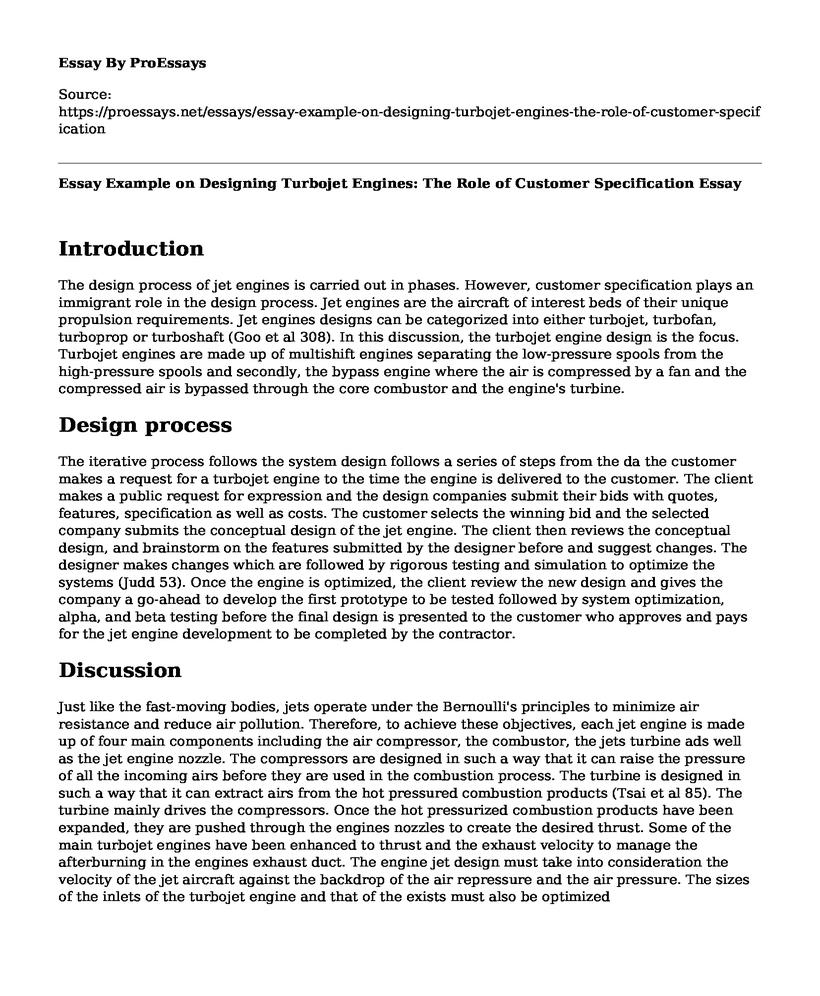Introduction
The design process of jet engines is carried out in phases. However, customer specification plays an immigrant role in the design process. Jet engines are the aircraft of interest beds of their unique propulsion requirements. Jet engines designs can be categorized into either turbojet, turbofan, turboprop or turboshaft (Goo et al 308). In this discussion, the turbojet engine design is the focus. Turbojet engines are made up of multishift engines separating the low-pressure spools from the high-pressure spools and secondly, the bypass engine where the air is compressed by a fan and the compressed air is bypassed through the core combustor and the engine's turbine.
Design process
The iterative process follows the system design follows a series of steps from the da the customer makes a request for a turbojet engine to the time the engine is delivered to the customer. The client makes a public request for expression and the design companies submit their bids with quotes, features, specification as well as costs. The customer selects the winning bid and the selected company submits the conceptual design of the jet engine. The client then reviews the conceptual design, and brainstorm on the features submitted by the designer before and suggest changes. The designer makes changes which are followed by rigorous testing and simulation to optimize the systems (Judd 53). Once the engine is optimized, the client review the new design and gives the company a go-ahead to develop the first prototype to be tested followed by system optimization, alpha, and beta testing before the final design is presented to the customer who approves and pays for the jet engine development to be completed by the contractor.
Discussion
Just like the fast-moving bodies, jets operate under the Bernoulli's principles to minimize air resistance and reduce air pollution. Therefore, to achieve these objectives, each jet engine is made up of four main components including the air compressor, the combustor, the jets turbine ads well as the jet engine nozzle. The compressors are designed in such a way that it can raise the pressure of all the incoming airs before they are used in the combustion process. The turbine is designed in such a way that it can extract airs from the hot pressured combustion products (Tsai et al 85). The turbine mainly drives the compressors. Once the hot pressurized combustion products have been expanded, they are pushed through the engines nozzles to create the desired thrust. Some of the main turbojet engines have been enhanced to thrust and the exhaust velocity to manage the afterburning in the engines exhaust duct. The engine jet design must take into consideration the velocity of the jet aircraft against the backdrop of the air repressure and the air pressure. The sizes of the inlets of the turbojet engine and that of the exists must also be optimized
Conclusion
The mechanical design of the engine can be challenging because the dynamics of the multiple rotor systems that are sent to the large gyroscopic couples requires proper analysis to design and implement. There are several features that influence the design language of the parts of the engine such as the fan. The LP/HP compressors are designed in such a way that the blade vibration and external factors such as the bird impacts do not cause dynamical problems. Nevertheless, it is important to accurately calculate creep and fatigue potential as well as the damage tolerance
Works Cited
Goo, Nam Seo et al. "Conceptual Design, Thrust Test, And Finite Element Analysis Of A Tip-Jet Rotor Using A Small Turbo-Jet Engine". Key Engineering Materials, 306-308, 2006, pp. 541-546. Trans Tech Publications, doi:10.4028/www.scientific.net/kem.306-308.541.
Judd, Frederick V. H. "The Aerodynamic Design Of Jet Engine Test Cells". Noise Control, vol 5, no. 5, 1959, pp. 50-53. Acoustical Society Of America (ASA), doi:10.1121/1.2369391.
Tsai, Bor-Jang et al. "Blade Design And Thrust Performance For A Miniature Turbojet Engine". International Journal Of Turbo And Jet Engines, vol 23, no. 3, 2006. Walter De Gruyter Gmbh, doi:10.1515/tjj.2006.23.3.137.
Virdi, Prabjot & Khan, Mohammed & Pereira, Nelroy & DSilva, Rolvin. Design and Fabricationof Major Components of Turbojet Engine. International Journal Of Turbo And Jet Engines. vol 12, no. 22, 2017. Doi:10.5923/j.ep.20170705.02.
Cite this page
Essay Example on Designing Turbojet Engines: The Role of Customer Specification. (2022, Dec 29). Retrieved from https://proessays.net/essays/essay-example-on-designing-turbojet-engines-the-role-of-customer-specification
If you are the original author of this essay and no longer wish to have it published on the ProEssays website, please click below to request its removal:
- Paper Example on Impact of Nanotechnology in Civil Engineering
- ITER Nuclear Fusion and Engineering Project Paper Example
- Research Paper on Construction Falls
- Essay Sample on Manifolds
- Boeing 737: A Legacy Model in Commercial Airlines - Research Paper
- Engineering Professionalism: Understanding Virtues and Obligations - Essay Sample
- Paper Example on Southeast Asia Aviation Industry: The Impact of Market Liberalization







